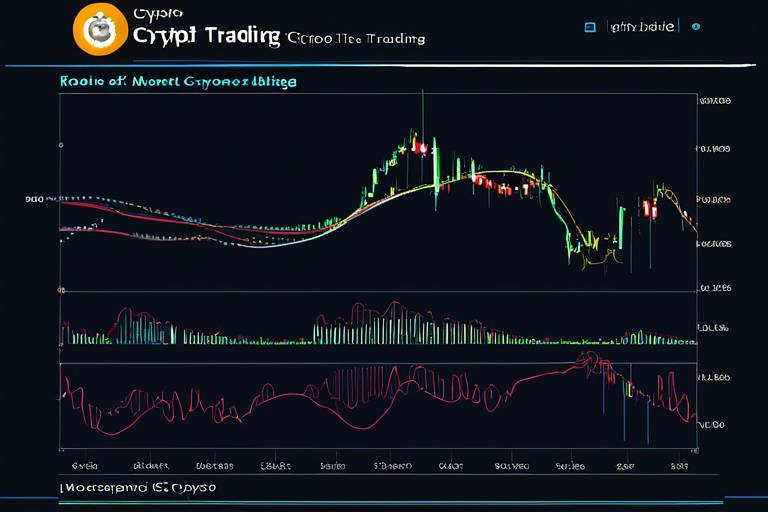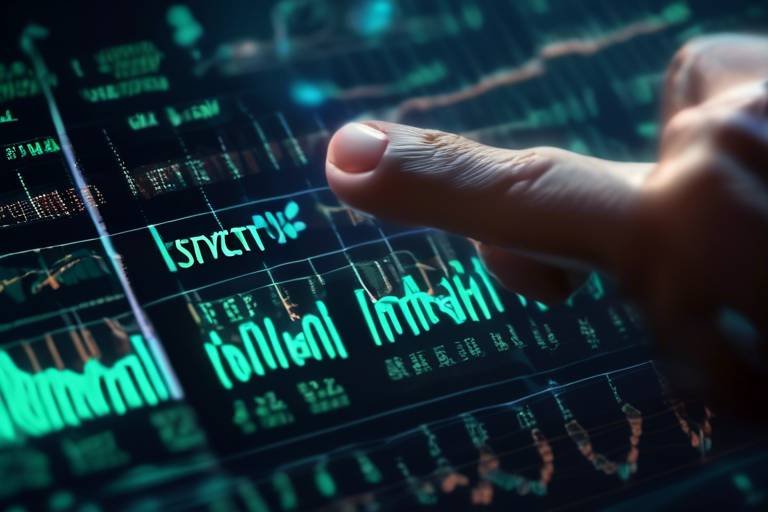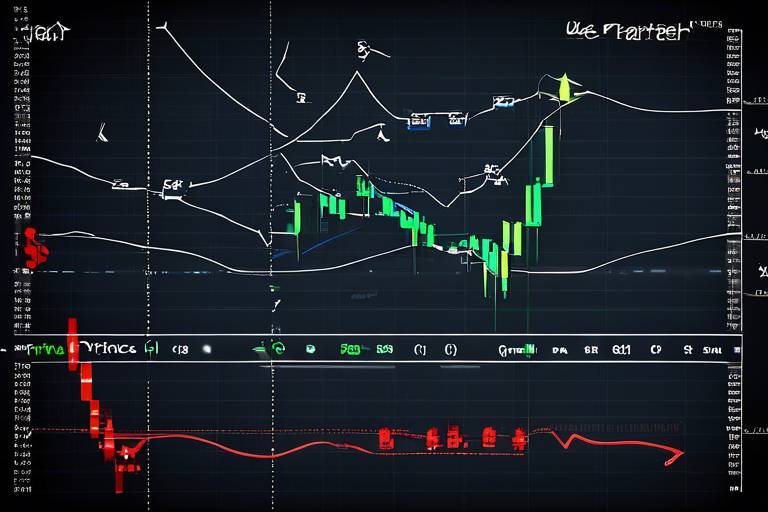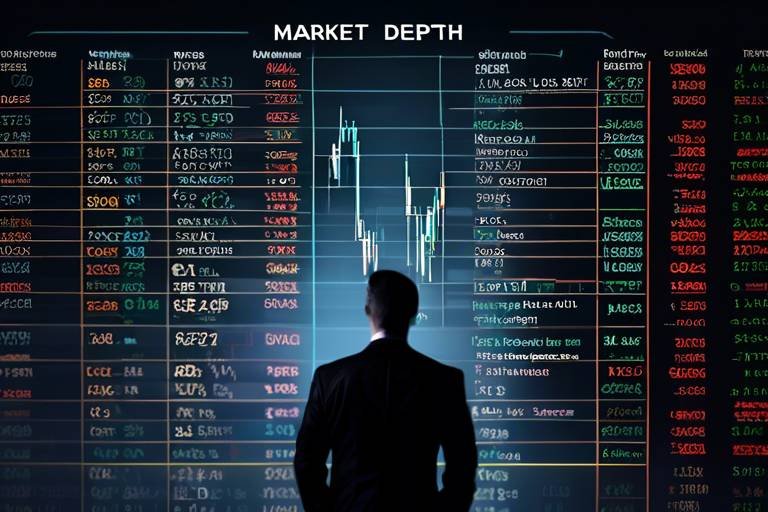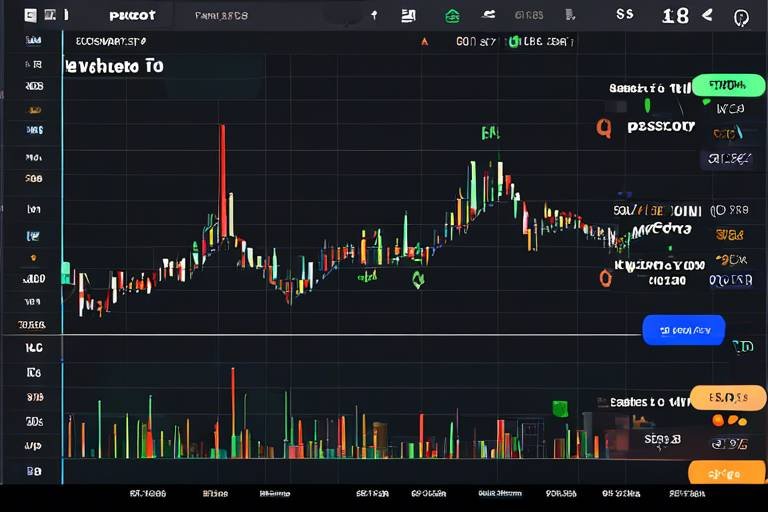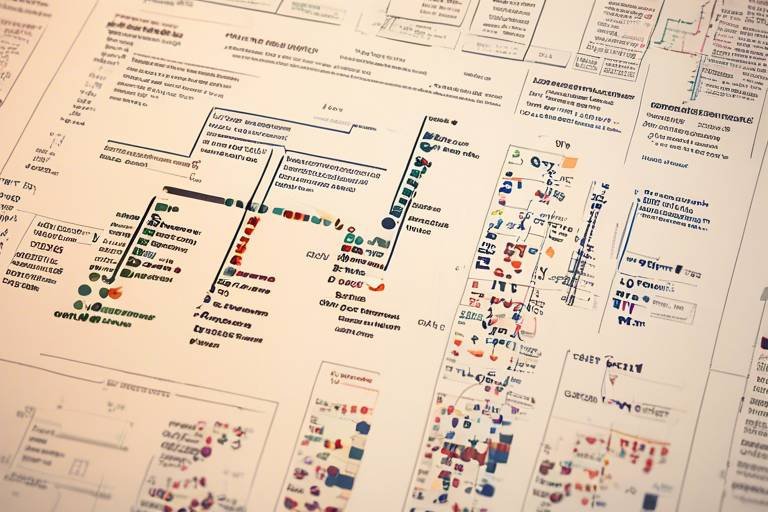The Role of Moving Average Crossovers in Crypto Trading
In the fast-paced world of cryptocurrency trading, making informed decisions can often feel like navigating through a stormy sea. One of the most effective tools traders use to find their way is the concept of moving average crossovers. These crossovers act like lighthouses, guiding traders through the fog of price volatility and helping them spot potential trading opportunities. But what exactly are moving average crossovers, and why are they so significant in the realm of crypto trading? Let’s dive deeper into this essential trading strategy.
At its core, a moving average crossover occurs when a short-term moving average crosses above or below a long-term moving average. This simple yet powerful signal can indicate a shift in market momentum. For instance, when a short-term average crosses above a long-term average, it often suggests that the price may continue to rise, presenting a potential buying opportunity. Conversely, when the short-term average crosses below the long-term average, it may signal a downturn, hinting that it might be time to sell. Understanding these signals is crucial for any trader looking to navigate the unpredictable waters of cryptocurrency.
What makes moving average crossovers particularly appealing is their ability to filter out the noise of daily price fluctuations. By smoothing out price data over a specific period, these averages allow traders to focus on the underlying trend rather than getting caught up in the moment-to-moment chaos. This makes them an invaluable tool for both novice and seasoned traders alike.
Moreover, the beauty of moving average crossovers lies in their adaptability. Traders can customize the time frames of the moving averages to suit their trading style. For instance, day traders might use shorter time frames, such as the 5-day and 20-day moving averages, while long-term investors might opt for longer periods, like the 50-day and 200-day averages. This flexibility allows traders to tailor their strategies based on their risk tolerance and market conditions.
However, it’s crucial to remember that while moving average crossovers can provide valuable insights, they are not foolproof. Like any trading indicator, they come with their own set of limitations. For example, in a sideways or choppy market, moving average crossovers can produce false signals, leading traders to make hasty decisions. Therefore, it’s essential to combine moving averages with other indicators and analysis techniques to enhance their effectiveness.
In conclusion, moving average crossovers play a pivotal role in crypto trading by helping traders identify potential buy and sell signals. They provide clarity in a world often clouded by uncertainty, allowing traders to make informed decisions based on trends rather than emotions. As you embark on your trading journey, consider incorporating moving average crossovers into your strategy, and remember to stay vigilant and informed!
- What is a moving average crossover? A moving average crossover occurs when a short-term moving average crosses above or below a long-term moving average, signaling potential trading opportunities.
- How do I use moving average crossovers in my trading strategy? You can use moving average crossovers to identify trends and potential entry or exit points by analyzing the relationship between short-term and long-term moving averages.
- Are moving average crossovers reliable? While they can provide valuable insights, moving average crossovers are not foolproof and should be used in conjunction with other indicators to improve accuracy.
- What types of moving averages are there? The primary types of moving averages include Simple Moving Averages (SMA) and Exponential Moving Averages (EMA), each with its unique characteristics and applications.

Understanding Moving Averages
Moving averages are essential tools in the world of trading, especially in the dynamic and often unpredictable landscape of cryptocurrency. They serve as a means to smooth out price data over a specified period, allowing traders to identify trends and make more informed decisions. Imagine trying to read a book while someone is constantly flipping the pages; it would be nearly impossible to grasp the story. Moving averages help eliminate that noise, providing a clearer picture of market movements.
At their core, moving averages calculate the average price of a cryptocurrency over a set timeframe, which can range from minutes to days or even weeks. By doing this, traders can spot whether the price is trending upwards, downwards, or remaining stable. This clarity is vital, especially in the volatile crypto market, where prices can swing dramatically in a matter of hours.
There are several types of moving averages, each with its unique characteristics and applications. The most common types include:
- Simple Moving Average (SMA): This is the most straightforward type, calculated by averaging the prices over a specific number of periods.
- Exponential Moving Average (EMA): Unlike the SMA, the EMA gives more weight to recent prices, making it more responsive to new information.
- Weighted Moving Average (WMA): This type assigns different weights to prices, allowing traders to emphasize certain periods more than others.
Understanding these types is crucial because they can significantly influence trading strategies. For instance, the SMA may be preferred for its simplicity and ease of calculation, while the EMA might be favored in fast-moving markets where recent price action is more relevant. Each type has its own set of advantages and limitations, which traders must consider when developing their strategies.
In the world of crypto trading, where every second counts, knowing how to effectively use moving averages can be the difference between profit and loss. They not only help in identifying trends but also play a pivotal role in signaling entry and exit points. For example, if a trader notices that the price has consistently stayed above the SMA for a certain period, it may indicate a bullish trend, prompting them to consider buying.
Moreover, moving averages can be integrated with other technical indicators to enhance trading strategies. By combining moving averages with tools like Relative Strength Index (RSI) or MACD, traders can gain deeper insights into market conditions, further refining their decision-making process. This synergy can lead to more robust trading strategies that adapt to changing market dynamics.
In summary, moving averages are not just numbers on a chart; they are powerful indicators that can guide traders through the complexities of the cryptocurrency market. By understanding their mechanics and applications, traders can harness their potential to improve their trading outcomes significantly.

Types of Moving Averages
When it comes to navigating the tumultuous waters of cryptocurrency trading, understanding the different types of moving averages is like having a reliable compass. Each type serves a unique purpose and can significantly influence your trading decisions. The three most common types of moving averages are the Simple Moving Average (SMA), Exponential Moving Average (EMA), and Weighted Moving Average (WMA). Let’s dive into what sets them apart and how they can be utilized in your trading strategy.
The Simple Moving Average (SMA) is the most straightforward of the bunch. It calculates the average price over a specified number of periods, giving equal weight to each price point. This makes it a great tool for identifying trends, but it can sometimes lag behind the market, especially in fast-moving conditions. For instance, if you're looking at a 10-day SMA, it will take into account the prices from the last ten days, which means it may not react quickly to sudden market changes.
On the other hand, the Exponential Moving Average (EMA) is designed to give more weight to the most recent prices, making it more responsive to new information. This characteristic is particularly beneficial in the volatile world of cryptocurrencies, where market conditions can change rapidly. Traders often prefer the EMA for its ability to capture price movements more promptly, which can be crucial for making timely trading decisions.
Lastly, we have the Weighted Moving Average (WMA). Similar to the EMA, the WMA assigns different weights to prices, but it does so in a more linear fashion. This means the most recent prices have more influence, but the weighting decreases gradually rather than exponentially. This can help traders find a middle ground between the SMA and EMA, providing a smoother trend line while still being somewhat reactive to price changes.
To summarize, here’s a quick comparison of the three types of moving averages:
| Type | Calculation Method | Responsiveness | Best For |
|---|---|---|---|
| Simple Moving Average (SMA) | Averages prices over a specified period | Low | Identifying long-term trends |
| Exponential Moving Average (EMA) | Gives more weight to recent prices | High | Capturing short-term price movements |
| Weighted Moving Average (WMA) | Assigns linear weights to prices | Medium | A blend of SMA and EMA benefits |
In conclusion, understanding the types of moving averages is essential for any trader looking to optimize their strategies. Each type has its strengths and weaknesses, and the choice between them often depends on your trading style and the specific market conditions you are facing. Whether you prefer the simplicity of the SMA, the responsiveness of the EMA, or the balanced approach of the WMA, incorporating these tools into your trading arsenal can provide valuable insights into market trends.

Simple Moving Average (SMA)
The is one of the most widely used indicators in the world of trading, particularly in the volatile realm of cryptocurrency. It is calculated by taking the average of a specific number of past prices over a defined time period. For instance, a 10-day SMA would average the closing prices of the last ten days. This straightforward approach helps traders to smooth out price fluctuations, making it easier to identify underlying trends. Imagine trying to read a book while someone is flipping the pages rapidly; the SMA acts like a bookmark, allowing you to focus on the story without getting lost in the chaos of daily price movements.
One of the primary advantages of using SMA is its simplicity. It provides a clear and easily interpretable view of price trends, which can be invaluable for both novice and seasoned traders. By observing the direction of the SMA, traders can gain insights into whether a cryptocurrency is trending upwards or downwards. For example, if the price is consistently above the SMA, it suggests a bullish trend, while prices below the SMA may indicate bearish conditions. However, it’s essential to note that while SMA can provide clarity, it does come with its own set of limitations.
Despite its usefulness, the SMA has a notable drawback: it tends to lag behind current price movements. This lag occurs because the SMA relies on historical data, which means that it may not react quickly enough to sudden market changes. For instance, if a cryptocurrency experiences a sharp price increase, the SMA will only reflect this change after several days, potentially causing traders to miss out on timely buying opportunities. Therefore, while the SMA can serve as a valuable tool for identifying trends, traders should be cautious and consider using it in conjunction with other indicators for a more comprehensive analysis.
In the crypto trading landscape, where volatility is the norm, understanding the SMA's role can significantly enhance trading strategies. Traders often use the SMA to identify points of support and resistance, which are crucial for making informed decisions. For example, if the price of Bitcoin consistently bounces off the 50-day SMA, traders might view this as a strong support level, indicating a potential buying opportunity. Conversely, if the price frequently fails to break above the 200-day SMA, it could signal a resistance level, suggesting that traders should be cautious about entering new positions.
To summarize, the Simple Moving Average is a fundamental tool in the trader's toolkit. Its ease of use and ability to highlight trends make it an attractive option for many. However, like any tool, it is most effective when used in combination with other indicators and strategies. By understanding both the advantages and limitations of the SMA, traders can make more informed decisions in the ever-changing world of cryptocurrency.

Advantages of SMA
The Simple Moving Average (SMA) is a powerful tool in the arsenal of any crypto trader, and its advantages are numerous. First and foremost, the SMA provides a clear visualization of price trends over a specified period. By averaging past prices, it smooths out the noise and volatility that often characterizes the cryptocurrency market. Imagine trying to read a book while someone is flipping the pages rapidly—it's nearly impossible to focus. The SMA acts like a bookmark, helping traders hone in on the broader narrative of price movements.
Another significant advantage of the SMA is its ease of calculation. Traders can quickly compute the SMA by summing up the closing prices over a set number of periods and dividing by that same number. This straightforward method makes it accessible for both novice and seasoned traders. For example, if you want to calculate a 10-day SMA, you simply take the closing prices of the last ten days, add them up, and divide by ten. This simplicity allows traders to focus more on strategy rather than getting bogged down in complex calculations.
Additionally, the SMA is particularly effective in identifying long-term trends. In a market as dynamic as cryptocurrency, where prices can fluctuate wildly, having a tool that highlights overarching trends can be invaluable. Traders often use the SMA to determine the general direction of the market—whether it’s bullish or bearish. This can help in making informed decisions about entry and exit points. For instance, if the SMA is trending upwards, it might indicate that prices are likely to continue rising, prompting traders to consider buying.
Moreover, the SMA can be effectively utilized in conjunction with other technical indicators, enhancing its predictive power. When combined with indicators like the Relative Strength Index (RSI) or Bollinger Bands, the SMA can provide a more comprehensive view of market conditions. This combination can help traders confirm signals and reduce the risk of making impulsive decisions based on incomplete information.
In summary, the advantages of using the Simple Moving Average in crypto trading include:
- Clarity in Price Trends: Smoothing out price data to identify long-term trends.
- Easy Calculation: Accessible for traders of all experience levels.
- Long-Term Trend Identification: Helps in determining the overall market direction.
- Compatibility with Other Indicators: Enhances decision-making when combined with other tools.
Understanding these advantages allows traders to leverage the SMA effectively, making it a cornerstone of their trading strategies. Whether you're just starting out or looking to refine your approach, the Simple Moving Average can provide the insights needed to navigate the often tumultuous waters of cryptocurrency trading.
What is a Simple Moving Average?
The Simple Moving Average (SMA) is a calculation that takes the average of a set number of past prices to smooth out fluctuations and identify trends.
How is SMA calculated?
To calculate the SMA, sum the closing prices for a specific number of periods and divide by that number. For example, for a 10-day SMA, add the closing prices of the last 10 days and divide by 10.
What are the benefits of using SMA in trading?
The benefits include clarity in identifying price trends, ease of calculation, effective long-term trend identification, and compatibility with other technical indicators.
Can SMA be used for short-term trading?
While SMA is often used for long-term trends, it can also be adapted for short-term trading strategies, especially when combined with other indicators.

Limitations of SMA
While the Simple Moving Average (SMA) is a popular tool among traders, it is not without its drawbacks. One of the primary limitations of SMA is its tendency to lag behind current price movements. This lag occurs because the SMA calculates its value based on a fixed number of past prices, which means it may not react swiftly to sudden market shifts. Imagine trying to catch a train that has already left the station; that's how SMA can feel during rapid price changes.
This lag can lead to missed opportunities. For instance, if a trader is relying solely on SMA to make decisions, they might find themselves entering a trade too late, resulting in diminished profits or even losses. Moreover, during periods of high volatility, the SMA can give false signals, leading traders to believe a trend is forming when it may not be. This phenomenon can be particularly dangerous in the fast-paced world of cryptocurrency trading, where prices can swing wildly in a matter of minutes.
Another limitation worth noting is that the SMA does not account for recent price movements as effectively as other types of moving averages, such as the Exponential Moving Average (EMA). This characteristic means that traders who rely heavily on SMA might overlook significant price changes that could influence their trading strategies. In a market as dynamic as cryptocurrency, this could mean the difference between a profitable trade and a significant loss.
Furthermore, SMA can sometimes create a false sense of security. Traders may believe that they are making informed decisions based on a clear trend identified by the SMA, but in reality, the lagging nature of this indicator could lead to poor timing. To illustrate this, consider the following table that compares SMA with EMA in terms of responsiveness and accuracy:
| Indicator | Responsiveness | Accuracy in Volatile Markets |
|---|---|---|
| Simple Moving Average (SMA) | Low | Moderate |
| Exponential Moving Average (EMA) | High | High |
In conclusion, while SMA can be a useful tool for identifying trends and smoothing out price data, traders should be aware of its limitations. Relying solely on SMA without considering other indicators or market conditions can lead to suboptimal trading decisions. To mitigate these risks, it's advisable to combine SMA with more responsive indicators, such as EMA, and to maintain a holistic view of market dynamics.

Exponential Moving Average (EMA)
The is a powerful tool in the arsenal of any cryptocurrency trader. Unlike the Simple Moving Average (SMA), which treats all past prices equally, the EMA gives more weight to the most recent prices. This characteristic makes the EMA particularly valuable in the fast-paced world of crypto trading, where price movements can be rapid and volatile. By focusing on the latest data, the EMA provides a more timely reflection of the current market sentiment, allowing traders to make quicker and more informed decisions.
One of the standout features of the EMA is its ability to react swiftly to price changes. For instance, if a cryptocurrency experiences a sudden surge in price, the EMA will adjust more rapidly than the SMA, which may lag behind due to its equal weighting of all past prices. This responsiveness can be crucial for traders looking to capitalize on short-term price movements. In fact, many traders use the EMA to identify potential entry and exit points, making it an essential component of their trading strategies.
To illustrate the effectiveness of the EMA, consider the following example. Imagine a trader is monitoring the price of Bitcoin. They decide to use a 10-day EMA to gauge the short-term trend. If the EMA line begins to rise sharply, it may signal that the price is gaining momentum, prompting the trader to consider buying. Conversely, if the EMA starts to decline, it could indicate a potential sell signal. This dynamic nature of the EMA helps traders stay ahead of market trends, which is especially important in the unpredictable crypto landscape.
However, like any trading tool, the EMA is not without its limitations. While it offers a clearer view of recent price trends, it can also produce false signals, particularly in sideways or choppy markets. Traders should be aware that relying solely on the EMA without considering other factors can lead to misinterpretations. Therefore, combining the EMA with other technical indicators, such as the Relative Strength Index (RSI) or Moving Average Convergence Divergence (MACD), can enhance its effectiveness and provide a more comprehensive view of market conditions.
In summary, the Exponential Moving Average is a vital component of crypto trading strategies, offering traders a more responsive and accurate representation of price trends. By understanding how to effectively implement the EMA, traders can better navigate the complexities of the cryptocurrency market and improve their decision-making processes.

Moving Average Crossovers Explained
Moving average crossovers are like the traffic lights of the trading world—they guide traders on when to go for it and when to hit the brakes. Essentially, a moving average crossover occurs when a short-term moving average (SMA or EMA) crosses above or below a long-term moving average. This crossover can act as a powerful signal for potential buy or sell opportunities, making it a crucial tool in the arsenal of any crypto trader. But how do you interpret these signals effectively? Let's dive in!
When a short-term moving average crosses above a long-term moving average, it's often referred to as a bullish signal. This is known as a Golden Cross, and it suggests that the price of the cryptocurrency is likely to rise. Imagine it as a green light, indicating that it's time to enter the market. Conversely, when the short-term moving average crosses below the long-term moving average, it's called a Death Cross, signaling a bearish trend and suggesting that it might be time to sell or at least tread carefully. Think of this as a red light, warning traders to stop and reassess their positions.
Understanding these signals is crucial, but it’s also essential to consider the context in which they occur. For instance, a Golden Cross in a strong uptrend can be a more reliable signal than in a sideways or choppy market. Similarly, a Death Cross in a volatile market might not hold as much weight. Traders often look at additional factors such as volume, momentum indicators, and market sentiment to confirm these crossover signals. Here’s a simple table to illustrate these concepts:
| Type of Crossover | Signal | Market Implication |
|---|---|---|
| Golden Cross | Buy Signal | Potential Bullish Trend |
| Death Cross | Sell Signal | Potential Bearish Trend |
It's also worth noting that moving average crossovers can vary depending on the time frames used. For example, a crossover on a 15-minute chart may signal a short-term trading opportunity, while a crossover on a daily chart might indicate a longer-term trend. Therefore, aligning your trading strategy with the appropriate time frame is key to maximizing the effectiveness of these signals.
In summary, moving average crossovers serve as vital indicators for traders seeking to navigate the often-turbulent waters of cryptocurrency trading. By understanding the mechanics behind Golden and Death Crosses, traders can make more informed decisions, potentially enhancing their profitability. However, as with any trading strategy, it's crucial to use these signals in conjunction with other tools and indicators to create a well-rounded approach to trading. Now, let’s move on to some frequently asked questions about moving average crossovers!

Golden Cross and Death Cross
The concept of Golden Cross and Death Cross is pivotal in the realm of crypto trading, acting as beacons that guide traders through the often tumultuous waters of market fluctuations. A Golden Cross occurs when a short-term moving average, typically the 50-day SMA, crosses above a long-term moving average, like the 200-day SMA. This crossover is widely regarded as a bullish signal, indicating that the momentum is shifting upward and suggesting that it might be a great time to buy.
On the flip side, the Death Cross is the opposite scenario. It happens when the short-term moving average crosses below the long-term moving average, signaling a potential bearish trend. This can be alarming for traders, as it often indicates that the market sentiment is turning negative, and it may be prudent to sell or short the asset. Understanding these two indicators can significantly enhance a trader's ability to make informed decisions.
To put it into perspective, think of the Golden Cross as a green light, illuminating the path ahead, while the Death Cross serves as a cautionary red light, warning you to slow down or stop. These signals can be particularly powerful when combined with other technical indicators, as they help to confirm the strength of a trend. For example, if a Golden Cross occurs alongside an increase in trading volume, this could further validate the bullish sentiment.
However, it’s crucial to remember that no indicator is foolproof. There are instances where false signals occur, leading traders to make hasty decisions. Hence, it’s advisable to approach these crossovers with a blend of caution and confidence. Many traders prefer to wait for additional confirmation through other indicators, such as the Relative Strength Index (RSI) or MACD, before fully committing to a trade based on these crossovers.
Here’s a quick comparison table to summarize the key differences between the Golden Cross and Death Cross:
| Indicator | Signal | Market Sentiment | Action |
|---|---|---|---|
| Golden Cross | Short-term MA crosses above long-term MA | Bullish | Consider buying |
| Death Cross | Short-term MA crosses below long-term MA | Bearish | Consider selling |
In conclusion, understanding the Golden Cross and Death Cross is essential for any crypto trader looking to navigate the market effectively. These indicators can act as powerful tools in your trading arsenal, but they should be used in conjunction with other analysis methods to ensure a well-rounded approach to trading.

Implementing Moving Average Strategies
When it comes to trading cryptocurrencies, the implementation of moving average strategies can be a game changer. Think of moving averages as your trusty compass in the unpredictable seas of the crypto market. They not only help you navigate through the waves of price fluctuations but also provide clarity on the direction you should be heading. By integrating moving average crossovers into your trading strategy, you can make more informed decisions that could potentially lead to profitable trades.
One effective way to implement these strategies is to focus on the timing of your trades. For instance, when a short-term moving average crosses above a long-term moving average, it can signal a buying opportunity. Conversely, when the short-term moving average dips below the long-term average, it may indicate a sell signal. This is often referred to as the "crossover strategy," and it’s essential to monitor these signals closely. However, it's not just about waiting for these crossovers; you need to consider the broader market context. Are there significant news events or market trends that could affect price movements? This is where a combination of technical analysis and fundamental analysis can prove invaluable.
Moreover, you might want to consider using multiple moving averages to create a more nuanced strategy. For example, employing both the 50-day and 200-day moving averages can give you insights into both short-term and long-term trends. The interplay between these two averages can help you identify potential entry and exit points more effectively. Here’s a quick comparison table to illustrate the differences:
| Type of Moving Average | Purpose | Recommended Timeframe |
|---|---|---|
| 50-Day SMA | Short-term trend identification | Days to weeks |
| 200-Day SMA | Long-term trend identification | Months |
Another vital aspect of implementing moving average strategies is risk management. Utilizing moving averages to set stop-loss orders can be an effective way to protect your investments. For instance, if you enter a trade based on a bullish crossover, you might set your stop-loss just below the moving average line. This way, if the market moves against you, your losses are limited. Remember, the goal is not just to maximize profits but also to minimize losses.
Furthermore, combining moving averages with other technical indicators can enhance the effectiveness of your trading strategy. For instance, you might consider using the Relative Strength Index (RSI) alongside your moving averages. If both indicators align—say, the moving average indicates a bullish trend and the RSI suggests the asset is not overbought—you may have a stronger signal to enter a trade. This multi-faceted approach can help you make more informed decisions and improve your trading outcomes.
In conclusion, implementing moving average strategies in your trading can provide a structured approach to navigating the complex world of cryptocurrency. By understanding the mechanics of moving averages, combining them with other indicators, and employing robust risk management techniques, you can enhance your trading decisions and potentially increase your profitability. Just remember, like any strategy, it’s essential to continually assess and adjust your approach as market conditions change.
- What is a moving average crossover? A moving average crossover occurs when a short-term moving average crosses above or below a long-term moving average, signaling potential buy or sell opportunities.
- How do I choose the right moving averages for my strategy? The choice of moving averages often depends on your trading style. Shorter periods (like 10-day or 20-day) are better for day trading, while longer periods (like 50-day or 200-day) suit long-term trading.
- Can I rely solely on moving averages for trading decisions? While moving averages are powerful tools, it’s wise to combine them with other indicators and fundamental analysis for a more comprehensive trading strategy.

Combining with Other Indicators
When it comes to navigating the unpredictable waters of crypto trading, relying solely on moving averages can sometimes feel like trying to sail a ship without a compass. While moving averages, whether they are Simple Moving Averages (SMA) or Exponential Moving Averages (EMA), offer valuable insights into market trends, combining them with other technical indicators can significantly enhance your trading strategy. Think of it as adding multiple layers to your trading toolkit; each layer provides a different perspective and helps to create a more comprehensive view of the market.
One popular combination is using moving averages alongside the Relative Strength Index (RSI). The RSI is a momentum oscillator that measures the speed and change of price movements. By assessing the RSI in conjunction with moving averages, traders can identify overbought or oversold conditions. For instance, if the price is above the EMA while the RSI indicates overbought conditions, it may signal a potential reversal, prompting traders to consider taking profits or tightening stop-loss orders.
Another effective pairing is moving averages with the Moving Average Convergence Divergence (MACD). The MACD is a trend-following momentum indicator that shows the relationship between two moving averages of a security's price. When the MACD line crosses above the signal line while the price is above the SMA, it can be interpreted as a strong bullish signal. Conversely, if the MACD line crosses below the signal line while the price is below the SMA, it may indicate a bearish trend. This combination provides traders with a clearer picture of potential entry and exit points.
Furthermore, incorporating volume indicators can also enhance the effectiveness of moving averages. Volume indicators show how much of a given asset has been traded during a specific period, which can confirm the strength of a price movement. For example, if a moving average crossover occurs alongside a significant increase in trading volume, it adds credibility to the signal. Traders might feel more confident entering a position when they see that many others are doing the same.
In summary, while moving averages are powerful tools in their own right, combining them with other indicators like RSI, MACD, and volume can create a more robust trading strategy. This multifaceted approach allows traders to make more informed decisions, reducing the risks associated with trading in the highly volatile cryptocurrency market. By layering these indicators, traders can develop a more nuanced understanding of market dynamics, leading to potentially more profitable trading outcomes.
- What are moving averages, and why are they important in crypto trading?
- How do I choose the right type of moving average for my trading strategy?
- Can I rely solely on moving averages for trading decisions?
- What is a Golden Cross, and why is it significant?
Moving averages help smooth out price data to identify trends over a specific period, making them essential for spotting potential buy and sell signals in the volatile crypto market.
The choice between SMA and EMA depends on your trading style. SMA is simpler and provides a clearer view of trends, while EMA reacts faster to price changes, making it more suitable for short-term trading.
While moving averages are valuable, it's advisable to combine them with other indicators for a more comprehensive analysis. This can help confirm signals and reduce the likelihood of false positives.
A Golden Cross occurs when a short-term moving average crosses above a long-term moving average, indicating a potential bullish trend. Traders often view this as a strong buy signal.

Risk Management with Moving Averages
When it comes to trading cryptocurrencies, risk management is not just a buzzword; it's a crucial aspect that can make or break your trading journey. One effective way to manage risk is by utilizing moving averages. They act as dynamic support and resistance levels, helping traders to make informed decisions rather than emotional ones. By analyzing the relationship between short-term and long-term moving averages, traders can set up strategic entry and exit points that minimize potential losses.
One of the most powerful strategies involves using moving averages to set stop-loss orders. A stop-loss order is like a safety net that helps protect your investments from significant losses. For instance, if you're using a Simple Moving Average (SMA) as a guide, you might set your stop-loss just below the moving average line. This way, if the price dips below the SMA, it triggers the stop-loss, safeguarding your capital. It's like having a guard dog that barks when something's off!
Moreover, moving averages can help you determine position sizing. By using the volatility indicated by the moving averages, you can adjust your trade size according to the level of risk you're willing to take. For example, if the market is particularly volatile, you might decide to decrease your position size to limit exposure. This approach aligns with the fundamental trading principle of never risking more than you can afford to lose.
To illustrate how moving averages can aid in risk management, consider the following table:
| Moving Average Type | Usage in Risk Management | Example |
|---|---|---|
| Simple Moving Average (SMA) | Setting stop-loss orders below the SMA | If SMA is at $50, set stop-loss at $48 |
| Exponential Moving Average (EMA) | Adjusting position size based on EMA volatility | Decrease position size during high volatility |
Additionally, moving averages can provide traders with a clearer view of market trends, helping them to avoid emotional trading decisions. When the price consistently stays above a moving average, it indicates a bullish trend, allowing traders to hold their positions with confidence. Conversely, if the price falls below the moving average, it could signal a bearish trend, prompting traders to consider exiting their positions. This systematic approach is akin to having a roadmap in an unfamiliar city, guiding you through potential pitfalls.
In summary, integrating moving averages into your risk management strategy can significantly enhance your trading effectiveness. They not only help in determining when to enter or exit a trade but also play a vital role in protecting your capital. By setting stop-loss orders and adjusting your position sizes based on market conditions, you can navigate the turbulent waters of crypto trading with greater assurance and less anxiety.
- What are moving averages? Moving averages are indicators that smooth out price data to help traders identify trends over a specific period.
- How can moving averages help in risk management? They can be used to set stop-loss orders, adjust position sizes, and provide insights into market trends.
- What is the difference between SMA and EMA? SMA gives equal weight to all prices in the period, while EMA gives more weight to recent prices, making it more responsive to new information.
- How do I set a stop-loss using moving averages? You can set a stop-loss just below the moving average level to protect against significant losses.
Frequently Asked Questions
- What are moving averages in crypto trading?
Moving averages are statistical calculations used to analyze price data over a specific period. They help traders identify trends by smoothing out price fluctuations, making it easier to spot potential buy or sell signals.
- What is the difference between Simple Moving Average (SMA) and Exponential Moving Average (EMA)?
The Simple Moving Average (SMA) calculates the average of a set number of past prices, treating all prices equally. In contrast, the Exponential Moving Average (EMA) gives more weight to recent prices, making it more responsive to new information. This can be particularly useful in volatile markets like cryptocurrency.
- How do moving average crossovers signal trading opportunities?
A moving average crossover occurs when a short-term moving average crosses above or below a long-term moving average. A crossover above (known as a Golden Cross) typically indicates a bullish trend, while a crossover below (known as a Death Cross) suggests a bearish trend. Traders use these signals to make informed buying or selling decisions.
- Can I use moving averages with other indicators?
Absolutely! Many traders combine moving averages with other technical indicators, such as Relative Strength Index (RSI) or MACD, to enhance their trading strategies. This combination can provide a more comprehensive view of market conditions and improve the accuracy of trading signals.
- What are the limitations of using moving averages?
While moving averages are valuable tools, they do have limitations. For instance, they can lag behind price movements, which may result in delayed signals. Additionally, in highly volatile markets, moving averages might give false signals, leading to potential losses if not used carefully.
- How can I manage risk using moving averages?
Risk management is crucial in trading. You can use moving averages to set stop-loss orders, which help limit potential losses. By placing stop-loss orders just below a moving average, you can protect your investment if the market moves against you.

